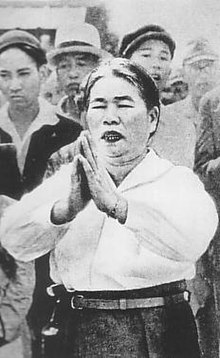You can help expand this article with text translated from the corresponding article in Japanese. (December 2018) Click for important translation instructions.
|


Tenshō Kōtai Jingūkyō (Japanese 天照皇大神宮教) is a Japanese new religious movement which emerged from Shinto. It was established by Sayo Kitamura (北村 サヨ) (1900–1967), with activities beginning in 1945. The movement includes 450,000 members. Kitamura claimed possession by Amaterasu under the title Tenshō-Kōtaijin.
Its headquarters are in Tabuse (田布施町, Tabuse-chō), a town in the district of Kumage District, Yamaguchi, Japan.
Followers practice a dance called muga no mai (無我の舞, "Dance of the non-self" or "Dance of the non-ego"), which is why the religion is called the "dancing religion" (踊る宗教, Odoru shūkyō).
See also
- Anatta / Anātman (jap. muga)
References
- "Glossary of Shinto Names and Terms: T". www2.kokugakuin.ac.jp (in Japanese). Retrieved 2018-10-16.
Further reading
- The Prophet of Tabuse (1954), published by Tensho-Kotai-Jingu-Kyo, Tabuse, Yamaguchi prefecture, Japan.
- Tina Hamrin: Dansreligionen i japansk immigrantmiljö på Hawai'i. Via helbrägdagörare och Jodu shinshu-präster till nationalistisk millennarism. (English summary: The Dancing Religion in a Japanese-Hawaiian Immigrant Environment). Stockholm: Almqvist & Wiksell International, 1996. (Acta Universitatis Stockholmiensis. Stockholm Studies in Comparative Religion) - Review
- NISHIYAMA Shigeru & FUJII Takeshi: The Propagation and Spread of Tenshô Kôtai Jingûkyô within Japanese-American Society on Hawaii Island at the Wayback Machine (archived 2014-04-21). 1991, 1997 Institute for Japanese Culture and Classics, Kokugakuin University.
- Clark B. Offner: The Work of the Holy Spirit in the Japanese Cultural Setting (PDF; 2,3 MB), S. 57ff.
- Sayo Kitamura: Tensho Kotai Jingu-Kyo (1): The Dancing Religion, Contemporary Religions in Japan 2 (3), (1961), 26–42
- L. Carlyle May: The Dancing Religion: A Japanese Messianic Sect, Southwestern Journal of Anthropology 10 (1), (1954), 119–137
External links
This article related to religion in Japan is a stub. You can help Misplaced Pages by expanding it. |